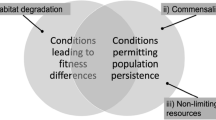Summary
Darwin's phrase “place in natural economy”, andSpencer's term “correspondence” can be regarded as first attempts to express the organism-environment relationships. The same concept has more recently been approached from the point of view of (1) life-form, (2) external activities, and (3) habitat. Though all these points are interlocking, they have been stressed differently in the writings of American and European ecologists. It is proposed that the term “niche” would be most useful and rational if applied to the total of relationships between a living organism (population, species) and its complete environment, both biotic and abiotic.
Similar content being viewed by others
Bibliography
Allee, W. C., A. E. Emerson, O. Park, T. Park &K. P. Schmidt (1949). Principles of animal ecology.-Philadelphia, London, W. B. Saunders & Co., 838 pp.
Balogh, J. (1958). Lebensgemeinschaften der Landtiere.-Budapest, Akadémiai Kiadó, 560 pp.
Bock, W. J. &G. von Wahlert (1965). Adaptation and form-function complex. -Evolution19, p. 269–299.
Clarke, G. L. (1954). Elements of ecology.-New York, Wiley, 534 pp.
Colwell, R. K. &D. J. Futuyma (1971). On the measurement of niche breadth and overlap.-Ecology52, p. 567–576.
Dale, M. B. (1970). System analysis and ecology.-Ecology51, p. 2–16.
Darwin, Ch. (1859). On the origin of species.-London, J. Murray, 490 pp.
Elton, C. (1927). Animal ecology.-London, Sidgwick & Jackson, 209 pp.
Emlen, J. M. (1973). Ecology: an evolutionary approach.-Reading, Mass., Addison-Wesley Publ. Comp., 493 pp.
Gallopin, G. C. (1972). Trophic similarity between species in a food web.-Amer. Midl. Natur.87, p. 336–345.
Gams, H. (1918). Prinzipienfragen der Vegetationsforschung.-Vierteljahrschr. Naturf. Ges. Zürich63, p. 293–493.
Grinnel, J. (1917). The niche-relationships of the California thrasher.-Auk34, p. 427–433.
— (1924). Geography and evolution.-Ecology5, p. 225–229.
Hutchinson, G. E. (1958). Concluding remarks.-Cold Spring Harbor Symp. Quant. Biol.22, p. 415–427.
— (1965). The ecological theatre and evolutionary play.-New Haven, Conn., Yale Univ. Press, 139 pp.
Jeuken, M. (1958). Function in biology.-Acta Biotheoret.13, p. 29–46.
Lavrenko, E. M. (1959). Osnovnye zakonomernosti rastitelnych soobščestv i puti ich izučenija.-In: Polevaja geobotanika, ed:E. M. Lavrenko &A. A. Korčagin, Izd. Akad. Nauk USSR, Moskva, Vol.1, p. 13–75.
Levins, R. (1965). Toward an evolutionary theory of the niche.-In:E. T. Drake, (ed.), Evolution and environment.-Yale Univ. Press, New Haven & London, p. 325–340.
— (1968). Evolution in changing environments.-Princeton, New Jersey, Princeton Univ. Press, 120 pp.
Maelzer, D. A. (1965). Environment, semantics, and system theory in ecology.-J. Theoret. Biol.8, p. 395–402.
Maguire Jr,B. (1973). Niche response structure and the analytical potentials of its relationships to the habitat.-Amer. Natur.107, p. 213–246.
Mason, H. L. &J. H. Langenheim (1957). Language analysis and the conceptenvironment.-Ecology38, p. 325–340.
May, R. M. (1973). On the theory of niche overlap.-Theoret. Pop. Biol.5, p. 297–332.
Mayr, E. (1970). Populations, species, and evolution.-Cambridge, Mass., Harvard Univ. Press, 453 pp.
Odum, E. P. (1959). Fundamentals of ecology. 2nd ed.-Philadelphia, Saunders, 546 pp.
Pianka, E. R. (1969). Sympatry of desert lizards (Ctenotus) in Western Australia. -Ecology50, p. 1012–1030.
Pielou, E. C. (1972). Niche width and niche overlap: a method for measuring them,-Ecology53, p. 687–692.
Raunkiaer, C. (1905). Types biologiques pour la géographie botanique.- Overs. Danske Vidensk. Selsk Forhandl.5, p. 347–437.
Remane, A. (1943). Die Bedeutung der Lebensformtypen für die Ökologie.-Biol. Gen.17, p. 164–182.
Savage, J. M. (1958). The concept of ecological niche, with reference to the theory of natural coexistence.-Evolution12, p. 111–112.
Schmithüsen, J. (1961). Allgemeine Vegetationsgeographie.-Berlin, Walter de Gruyter, 262 pp.
Shugart, Jr.,H. H. &B. C. Patten (1972). Niche quantification and the concept of niche pattern.-In:B. C. Patten, (ed.): Systems analysis and simulation in ecology, Vol.2, p. 283–327.-New York and London, Academic Press.
Spencer, H. (1915). The principles of biology, Vol.1.-New York, D. Appleton and Comp., 706 pp.
Spomer, G. G. (1973). The concept of “interaction” and “operational environment” in environmental analyses.-Ecology54, p. 200–204.
Šennikov, A. P. (1964). Vvedenie v geobotaniku.-Leningrad, Izd. Leningrad. Univ., 447 pp.
Troll, C. (1968). Landschaftsökologie.-In: R.Tüxen, (ed.) Pflanzensoziologie und Landschaftsökologie.-Stolzenau/Weser., p. 1–21.
Udvardy, M. F. D. (1959). Notes on the ecological concepts of habitat, biotope and niche.-Ecology40, p. 725–728.
Vandermeer, J. H. (1972). Niche theory.-Ann. Rev. Ecol. Syst.3, p. 107–132.
Walter, H. (1960). Standortslehre.-In:Walter, H., ed. Einführung in die Phytologie 3/1.-Stuttgart, 566 pp.
Warburg, M. R. (1965). The evolutionary significance of the ecological niche.- Oikos16, p. 205–213.
Warming, E. (1884). Ueber perenne Gewächse.-Bot. Centralbl.18, p. 184–188.
Whittaker, R. H. (1970). Communities and ecosystems.-New York, MacMillan, 162 pp.
— (1972). Evolution and measurement of species diversity.-Taxon21, p. 213–251.
—,S. A. Levin &R. B. Root (1973). Niche, habitat, and ecotope.-Amer. Natur.107, p. 321–338.
Wuencher, J. E. (1969). Niche specification and competition modeling.- J. Theoret. Biol.25, p. 436–443.
Zlatník, A. et al. (1973)- Základy ekologie.-Praha, Stát. zeměd. naklad., 281 pp.
Author information
Authors and Affiliations
Rights and permissions
About this article
Cite this article
Rejmánek, M., Jeník, J. Niche, habitat, and related ecological concepts. Acta Biotheor 24, 100–107 (1975). https://doi.org/10.1007/BF01556997
Received:
Revised:
Issue Date:
DOI: https://doi.org/10.1007/BF01556997




